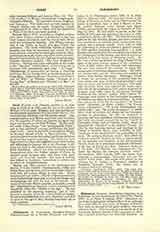

Clemencet, CHARLES, Benedictine historian, b. at Painblanc, in the department of Cote-d’Or, France, 1703; d. at Paris, August 5, 1778. Clemencet entered the Congregation of Saint-Maur at an early age; for a short time he was lector of rhetoric at Pont-le-Voy, but, on account of his great abilities, was soon called to Paris. Here he took part in almost all of the important literary labors of his congregation, showing a marked preference for historical research. At first his superiors commissioned him to edit the “Bibliotheca” (Myriobiblion) of Photius. Clemencet soon retired from this task and devoted all his powers to a chronological work for which Dantine, another member of the congregation, had made the preparatory studies. This chronology, Clemencet’s principal work, had the very prolix title: “L’art de verifier les dates ou faits historiques des chartes, des chroniques, et anciens monuments depuis la naissance de Jesus-Christ, par le moyen d’une table chronologique, oil l’on trouve les annees de Jesus-Christ et de l’Ere d’Espagne, les Indictions, le Cycle pascal, les Paques de chaque annee, les Cycles solaires et lunaires. Avec un Calendrier perpetuel, l’Histoire abregee des conciles, des papes, des empereurs romains, grecs, francais, allemands et turcs; des Rois de France, d’Espagne et d’Angleterre, d’Ecosse, de Lombardie, de Sicile, de Jerusalem, etc., des Dues de Bourgogne, de Normandie, de Bretagne; des Comtes de Toulouse, de Champagne et de Blois par des religieux benedictins de la congregation de Saint-Maur” (Paris, 1750). The work was compiled with extraordinary industry, and contains, as the title shows, a large amount of historical material. In its judgment of persons and facts, however, it betrayed a strong bias to Jansenism and Gallicanism, and was, consequently, frequently attacked, one opponent in particular being the Jesuit Patouillet. The assertion was made, and not without reason, that the title ought to read: “L’art de verifier les dates et falsifier les faits”.
Clemencet also wrote volumes X and XI, issued at Paris, 1756 and 1759, of the monumental work “Histoire litteraire de la France“. The volumes prepared by Clemencet are a rich collection of authorities, and are of importance not only for the literary history of France but also for the history of the development of all the nations of the Middle Ages. It was intended that he should edit volume XII of the “Histoire litteraire”, preparing for it the life of St. Bernard of Clairvaux, but he gave up the undertaking and wrote instead an independent work entitled: “Histoire des vies et ecrits de Saint-Bernard et de Pierre le Venerable” (Paris, 1773). His strong predilection for Jansenism is shown in two of his writings, namely: “Histoire generale de Port-Royal depuis la reforme de cette abbaye jusqu’a son entiere destruction (10 vols., Amsterdam, 1755-1757), and “Conferences de la Mere Angelique de Saint-Jean, Abbesse de Port-Royal” (3 vols., Utrecht, 1760). Of the former of these two works only the first half could be published, as the second part contained too strong a defense of Jansenism. On account of his leaning to Jansenism, Clemencet was a bitter opponent of the Jesuits. He attacked them in several exceedingly sharp pamphlets and worked for the suppression of the Society. Among his literary labors should also be mentioned his share in an excellent edition of the works of St. Gregory of Nazianzus. Prudentius Maranus, and other member of the Congregation of Saint-Maur, had begun the task. Clemencet issued the first volume under the title: “Gregorii Theologi opera quae extant omnia” (Paris, 1778). This edition is still valuable and far surpasses all the earlier editions.
PATRICIUS SCHLAGER

